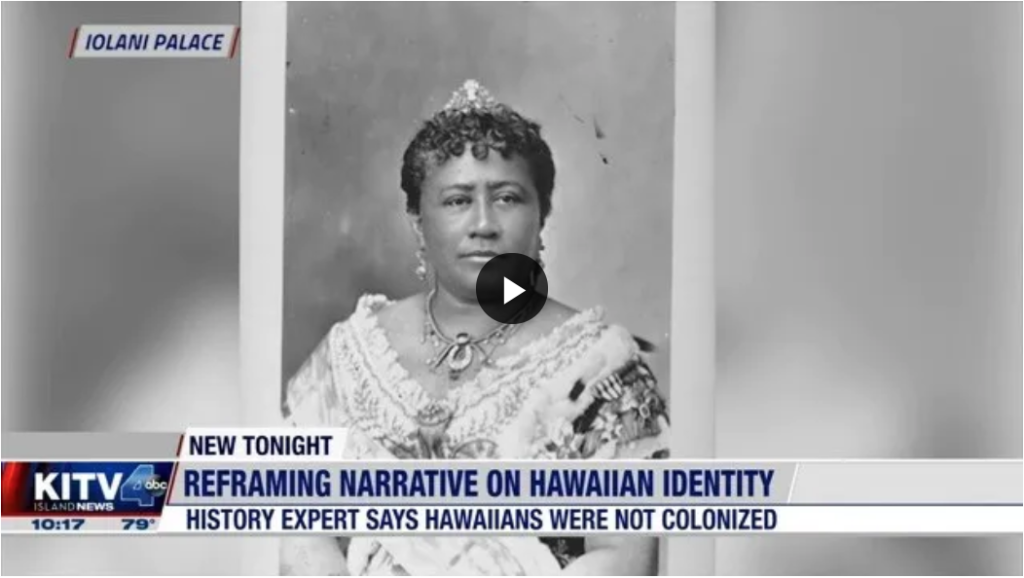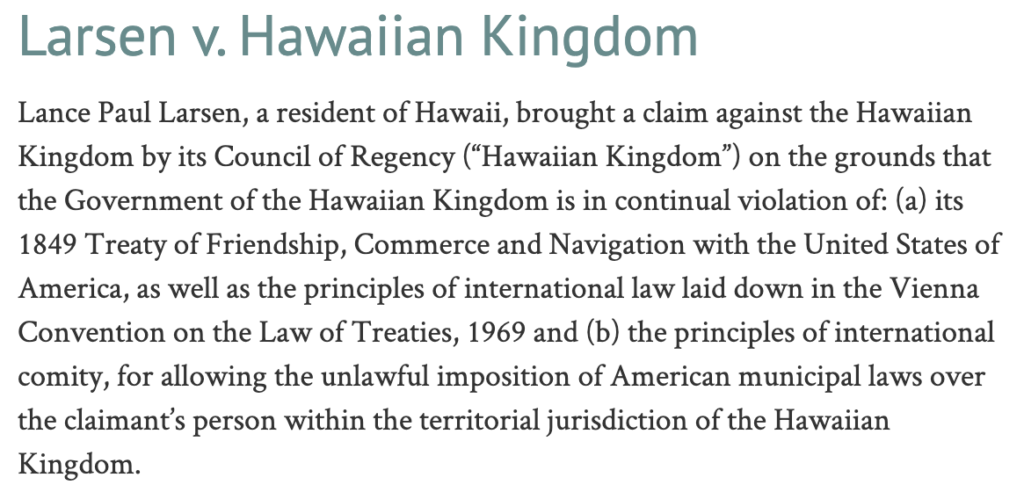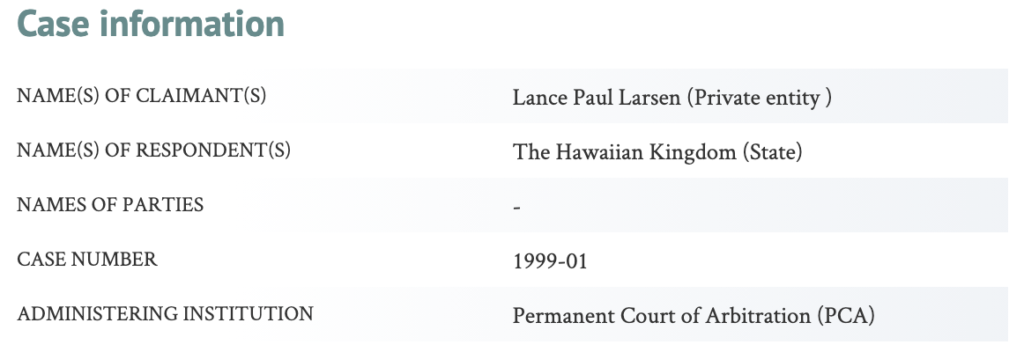
Click here for the KITV story.


Click here for the KITV story.
Law comprises a set of rules that regulate the behavior of persons, to include businesses and organizations, within a country. In a constitutional monarchy, laws reflect the national consciousness of its subjects because they directly enact legislation for the country as members of the legislative branch, which are then signed into law by the Monarch.
In 1840, the Hawaiian Kingdom was transformed from an absolute monarchy to a constitutional monarchy under a written constitution. This constitution was succeeded by the 1852 constitution, and then by the 1864 constitution, which is the present constitution of the country. According to the 1864 constitution there are three Estates in the Kingdom: the Monarch, the Nobility, and the People. The Monarch appoints Nobles to the Legislative Assembly, but their number cannot exceed 20. Representatives are elected by the People, which always outnumbered the Nobles in the Legislative Assembly where both Estates sat together in a unicameral legislative body. Prior to 1864, there were two separate houses in the legislature, the House of Nobles and the House of Representatives.
On June 21, 1850, both Houses of the Hawaiian Legislature enacted the Penal Code for the Hawaiian Kingdom. Under Hawaiian law, imprisonments for all crimes are at hard labor. Hawaiian crimes are felonies if the imprisonment is two years or more, or misdemeanors if imprisonment is less than two years. Like the United Kingdom, there is no statute of limitations for Hawaiian crimes.
Under Chapter 37 was the misdemeanor crime of “Common Nuisance.” Section 1 states, “The offense of common nuisance is the endangering of the public personal safety or health. … As, for example, the…spreading or endangering the spreading of…infectious disease.” Endangering the spreading is placing the “public personal safety or health at risk.” Section 9 and 10 provides for the punishment. “9. Whoever is guilty of the offense of common nuisance in the first degree…shall be punished by imprisonment at hard labor not more than six months, or by fine not exceeding five hundred dollars. 10. Whoever is guilty of the offense of common nuisance in the second degree…shall be punished by imprisonment at hard labor not more than two months, or by fine no exceeding twenty-five dollars.” According to the Penal Code, malice “includes the acting with a heedless, reckless disregard or gross negligence of the life or lives, the health or personal safety, or legal rights or privileges of another or others, many or few, known or unknown.”
In 1868, the Legislative Assembly enacted a statute directing the Judges of the Supreme Court to compile and revise the 1850 Penal Code. On April 3, 1869, the revised Penal Code came into effect and included thirty-six additional chapters, and the common nuisance chapter was changed from Chapter 37 to Chapter 36. Spreading an infectious disease is a serious crime under Hawaiian law.
According to §12 of the Hawaiian Civil Code, “One of the most effectual ways of discovering the true meaning of the law…is by considering the reason and spirit of it, or the cause which induced the Legislature to enact it.” The single most threat to the aboriginal Hawaiian population was the introduction of infectious diseases that decimated the population. In 1848, Governor Kekuanāo‘a made the following report that was published in Ka Elele Hawaii newspaper. The report was in Hawaiian, but an English translation is provided by Awaiaulu, Inc.
Regarding Illness in Hilo. Regards to you, the Elele. All of the students of this school are afflicted with the contagious smallpox. Previously, some individuals had coughs. They did not have whooping cough. At church service yesterday, there was one boy with whooping cough. Some had fevers, perhaps two, almost exactly like the illness of 1847. Many are somewhat fatigued. Different sick ones may have frequent cramps or headaches.
Malo is carrying out his duties among the folks of this area. In a nearby land area, there are perhaps 80 who are doing required public service. 18 of them have died since the contagious smallpox got here. Most were strong and able-bodied.
Illness at Lahaina. Lahaina has illness much like what is seen here in Honolulu. There is smallpox and whooping cough. Earlier, all the children had whooping cough, and afterwards, all the adults had already contracted it, and we heard that some have died.
Illness at Molokaʻi. Most of the people here are very ill. Some have died, and many more have the coughing illness. There are many sick folk at Hālawa. Someone dies there nearly every day. Few individuals went to church services on the last Sabbath. At services in the new month, there were none. There is no school at this time. All of the teachers are sick, as are most of the students. There have been no deaths among those who drank the medicine that we provided.
Illness at Honolulu. Here below is the letter from the Governor, M. Kekūanāoʻa, regarding those who died in the two week period from the 1st to the 15th of this November.
Fort of Honolulu. 18 November, 1848. Regards. I am reporting to you about the number those who died from Waikīkī to Moanalua in these past two weeks of November. Waikīkī, 7 dead. Honolulu area and Honolulu town, 271 dead. Kapālama, 7 dead. Kalihi, 24 dead. Moanalua, 7 dead.
You should publish this in the Elele Hawaii, and announce it in churches during services, which is all I have to say to you, with appreciation. M. Kekūanāoʻa.
If those numbers of the reported deaths are added up, it equals 380. And if you divide it by the 15 days, you get 25, that being the number of people who died each single day.
Illness at Waialua (Oʻahu). A letter from there states thus: Everyone here is ill, and some, if not ill, are recovering. Not many have actually died. There were perhaps ten that I heard of, and some of them had been infirm previously.
Extensive death has just hit here in Honolulu. Chiefs are dying, as are their people. Those of status great and small are entering the house of darkness. The wrongdoers and the righteous all end up falling.
This last Sabbath, Iakoba Malo, an attendant of Leleiōhoku, passed on. He was born on Hawaiʻi; he had always been a chiefs attendant, and was nearly 70 when he died. For many years he had been a servant of God, and appeared to be truly pious, steadfast to the oath he had made. It was never heard about him being in trouble, though he was connected to the royal circles, but did not get involved in pleasure seeking or wantonness because of where he resided. That was because his faith in Almighty God was sincere. He died with hope on God’s holy day. Smallpox and its resulting diarrhea were the causes of his death.
Here is another death: Mose Kekūāiwa, the son of Kekūanāoʻa and Kīnaʻu, died on the 24th of November; He was 19 years and four months old. He attended the Chiefs’ Children’s School for seven years, and mastered the English language. His body had been weakened previously by this illness, and when he contracted smallpox again, along with a cough, he passed on. How tragic is the death of the young!
Here is another: Ioana Kaʻiminaʻauao, the foster daughter of Kalama, wife of the king. She was three years and two days old. Kapaʻakea and Keohokālole were her actual parents. Liver failure was the cause of her death.
This as well: On the 19th of November, John Meek Jr. died, he being the firstborn of Captain J. Meek, and being 27 years old.
Because the printers have been ill, the Elele was not published at its usual time. Perhaps it will be published at its customary time in the future. Those who want a good paper should write articles for it. There are few who are writing articles; some have nearly abandoned this. Those who care about the Elele should give this careful consideration.
There is no doubt that Governor Kekuanāo‘a’s 1848 report on the carnage from disease and virus across the Hawaiian Islands influenced the legislators’ 1850 common nuisance criminal statute of “spreading or endangering the spreading of…infectious disease.” This led to the formation of the Hawaiian Board of Health and the establishment of the Queen’s Hospital that provided free healthcare for aboriginal Hawaiians throughout the Hawaiian Islands.
Like the smallpox virus in the Hawaiian Kingdom, COVID-19 is an infectious disease under Hawaiian law, which has risen to a level of a pandemic in the Hawaiian Islands and the world. The Hawaiian public personal safety and health has been directly impacted by the spreading of COVID-19 and the only “scientific” defenses to the virus are vaccinations, quarantine, masks, and social distancing. Yes, there is no Hawaiian law that mandates these COVID-19 defenses because this virus didn’t exist then, but the common nuisance law exists that includes COVID-19 as an infectious disease. These “scientific” defenses, however, is what prevents the “spreading or endangering the spreading of” COVID-19.
§7 of the Hawaiian Civil Code states, “individuals may, in all cases in which it is not expressly or impliedly prohibited, renounce what the law has established in their favor, when such renunciation does not affect the rights of others, and is not contrary to the public good.”
Don’t commit the Hawaiian crime of common nuisance. Stop spreading COVID-19. It’s the law.
As Hawai‘i’s people begin to awake to the reality of their country, the Hawaiian Kingdom, having been under an illegal and prolonged occupation by the United States since January 17, 1893, they have to contend with conflicting information on a daily basis. It is like walking down the hallway of a house in the dark. Every door that opens is someone telling “their” story with evidence “they” gathered that “they” say supports “their” conclusion. Which story is accurate and which story is not? There needs to be some sort of standard to discern fact from fiction whether it is about the Hawaiian Kingdom or COVID-19 that is in the Hawaiian Kingdom.
Stories are called anecdotes, and information that someone may use to tell the story could be anecdotal evidence. “Anecdotal Evidence is information you obtain from a subjective report, an observation, or some kind of example that may or may not be reliable. In addition, anecdotal evidence is not scientifically valid or representative of a larger group or of conditions in another location.” In academic research, anecdotal evidence is considered a fallacy. The anecdote is the story to be told and the evidence is selectively chosen by the storyteller to support the story. This is commonly referred to as “confirmation bias” or “cherry picking” because the storyteller would ignore evidence that would undermine the story being told.
Anecdotal evidence is on the opposite spectrum of science, which is “the intellectual and practical activity encompassing the systematic study of the structure and behavior of the physical and natural world through observation and experiment.” In political science, which is social science, it is “the systematic study of governance by the application of empirical and generally scientific methods of analysis. As traditionally defined and studied, political science examines the state and its organs and institutions.”
In both the hard sciences and the social sciences, there is a reliance on theory, which is an explanation of a set of known facts. A simple way to think of it is that the theory of football exists to explain the facts of a football game. Both sciences have a critical component called research and research relies on theories and evidence.
One of the ways to discern a person using anecdotal evidence from a person using scientific evidence is to first see their credentials, whether professional or academic, that would indicate that they have a particular expertise in the subject area. You should not prefer a golf coach to explain to you a football game. Second, does the person have published articles on the subject that has been peer-reviewed. This is very important because peer-review is a form of a vetting process that qualifies a person’s explanation and conclusions of a particular subject.
The way peer-review works is a journal’s editorial board will receive a manuscript that represents the author’s research and findings. If the manuscript satisfies the editorial board’s criteria of topic and form, the editorial board will seek out academics that are recognized as experts in certain fields that are covered in the manuscript. A peer-review journal can have up to 4 referees to review and provide comment on the manuscript. Peer-review is usually double blind where the referees do not know who the author is, and the author does not know who the referees are. All the author knows is that the referees are experts in certain fields that the editorial board reached out to.
After the reviews by the referees are submitted to the editorial board, the board will go over the comments made by the referees and determine whether the manuscript is suitable for publication. Some manuscripts would be rejected, while others would be conditionally accepted with adjustments as recommended by the referees. A manuscript based on anecdotal evidence would not be accepted for publication from the start.
In the case of the Hawaiian Kingdom, the vetting process was the Permanent Court of Arbitration (PCA), in Larsen v. Hawaiian Kingdom. Larsen sought to hold the government of the Hawaiian Kingdom legally accountable for allowing the unlawful imposition of American municipal laws over him that caused him to have an unfair trial and be subsequently incarcerated. However, before the PCA could form an arbitration tribunal to resolve the dispute, it had to ensure that the institution had jurisdiction or authority to do so in the first place.

Article 47 of the 1907 Hague Convention (PCA) only allows access to the PCA if one of the parties is a “State” recognized under international law. The proceedings were instituted on November 8, 1999, and after the PCA verified the Hawaiian Kingdom to be a “State” an arbitration tribunal was formed on June 9, 2000. The Secretariat of the PCA, also known as the International Bureau, served as a vetting institution, and after its due diligence in reviewing the evidence through the legal theory of international law, it concluded that the Hawaiian Kingdom is an independent State.

This finding by an intergovernmental institution, falsifies the storytellers using anecdotal evidence. Since then, academics have published peer-review journal articles and publications that speak to the Hawaiian Kingdom as a State in continuity that has been under a prolonged belligerent occupation by the United States since January 17, 1893.
In this time of the pandemic, it is crucial to distinguish anecdotal evidence from scientific evidence. Dr. Anthony Fauci is an expert in this field, and he does have the credentials. More importantly, Dr. Fauci has publications on the topic of COVID-19 in peer-review journals. If Dr. Fauci lived in nineteenth century, the Hawaiian Kingdom Government’s Board of Health would have relied on his opinions and recommendations regarding COVID-19 if it arrived in the Hawaiian Islands.